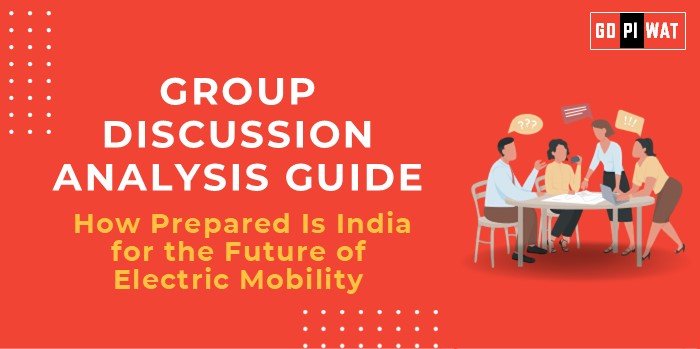📋 Group Discussion (GD) Analysis Guide
🔌 How Prepared Is India for the Future of Electric Mobility?
🌟 Introduction to the Topic
Opening Context: Electric mobility is reshaping the global automotive and transportation industry, with nations vying to lead the transition towards sustainable energy solutions. India’s ambitious targets for EV adoption highlight its intent to be a part of this revolution.
Background: India’s electric vehicle (EV) push began with the National Electric Mobility Mission Plan (NEMMP) 2020, later supplemented by the Faster Adoption and Manufacturing of Hybrid and Electric Vehicles (FAME) schemes. These initiatives aim to reduce dependency on fossil fuels and curb emissions.
📊 Quick Facts and Key Statistics
- EV Adoption Target: India aims for 30% EVs by 2030 (NITI Aayog, 2023).
- EV Sales Growth: EV sales in India crossed 1.2 million units in 2023, a 120% increase from 2022 (SIAM).
- Charging Infrastructure: Over 10,000 public charging stations installed as of 2024 (CEA).
- Battery Production: ₹18,100 crore allocated under the PLI scheme for Advanced Chemistry Cell (ACC) battery manufacturing.
👥 Stakeholders and Their Roles
- Government: Policies like FAME, subsidies, tax benefits, and PLI schemes.
- Automobile Industry: Key manufacturers transitioning to EV production.
- Energy Sector: Investments in battery manufacturing and charging infrastructure.
- Citizens: Adoption influenced by affordability and convenience.
- Global Collaborators: Partnerships for technology transfer and investment.
🎯 Achievements and Challenges
🏆 Achievements:
- Policy Support: FAME-II disbursed ₹10,000 crore in subsidies.
- Industry Participation: Major automakers like Tata Motors and Mahindra invested in EVs.
- Battery Innovation: ACC production reduces reliance on imports.
- Global Positioning: India among the top 10 EV markets globally.
⚠️ Challenges:
- Infrastructure Deficit: Charging networks insufficient for mass adoption.
- High Costs: Battery manufacturing and EV prices remain a barrier.
- Supply Chain Issues: Dependence on imported lithium and components.
- Awareness and Trust: Public hesitation around EV reliability and range anxiety.
🌍 Global Comparisons
- China: Leads in EV production and infrastructure, with 6 million EVs sold in 2023.
- Norway: Over 80% of new car sales in 2023 were EVs, supported by robust incentives.
📖 Structured Arguments for Discussion
- Supporting Stance: “India’s EV sector is on a strong growth trajectory due to proactive policies and increasing investments.”
- Opposing Stance: “Without significant improvements in infrastructure and affordability, India may struggle to meet its ambitious EV targets.”
- Balanced Perspective: “While India has made commendable progress, achieving sustainable EV adoption requires addressing key challenges like infrastructure and supply chains.”
🗣️ Effective Discussion Approaches
🎤 Opening Techniques:
- Statistic-Driven Start: “India’s EV sales surged by 120% in 2023, indicating growing interest in sustainable transport.”
- Comparative Insight: “China’s success in building EV infrastructure offers critical lessons for India.”
🔄 Counter-Argument Handling:
- Address infrastructure gaps by citing PLI scheme advancements.
- Acknowledge cost barriers but highlight long-term savings from EVs.
📊 SWOT Analysis
- Strengths: Government support, rising awareness, domestic industry growth.
- Weaknesses: Infrastructure gaps, dependency on imports.
- Opportunities: Export potential, technological collaborations.
- Threats: Competitive global market, supply chain vulnerabilities.
🏫 Connecting with B-School Applications
- Real-World Applications: Operations projects on optimizing EV supply chains; finance projects on EV market analysis.
- Sample Interview Questions:
- “What role do public-private partnerships play in India’s EV transition?”
- “Evaluate India’s potential to lead in EV battery manufacturing globally.”
- Insights for Students: Focus on policy analysis, infrastructure challenges, and opportunities in EV financing.


